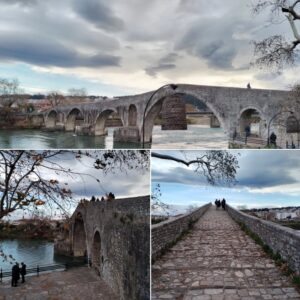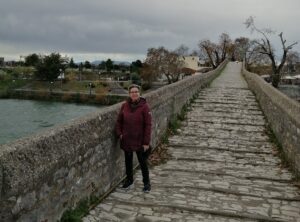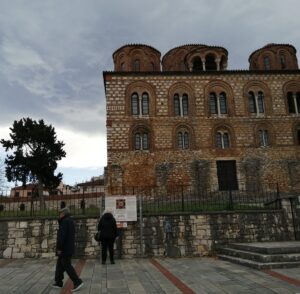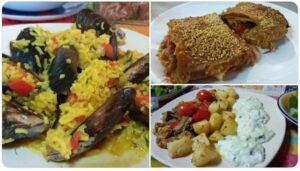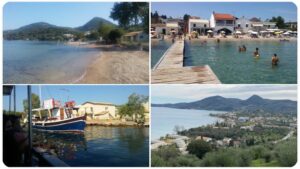The haunting legend of the Bridge of Arta
During my Christmas journey to Epirus, I had the pleasure to visit the Bridge of Arta. Oddly enough, I had seen it dozens of times in my life, but only from afar and for a few seconds at a time, just passing through in the family car, as my father drove us to Corfu. Somehow, we never stopped to see it. I guess we were always too excited and eager to get to Igoumenitsa for the ferry crossing on time, LOL!
So, anyway, the time finally came for me to see the legendary bridge of Arta, and it was absolutely worth the wait.
The site is beautiful with a cafe and a local produce store on the side where our coach left us. Walking along the bridge offers picturesque views as the sound of rushing waters from the river Arachthos reaches the ears.
This magnificent stone bridge was built in the 1600s and typically carries the legend of sacrifice related to various stone bridges all over Epirus.
The folk poem is in old Greek and thus quite lyrical as it rolls out the tongue, but I’ll do my best not to ruin it in the translation to English. Here goes one small excerpt:
Forty-five masons and sixty apprentices
Were contstructing a bridge on the river of Arta
All day they built it, and at night it would collapse.
A little bird went and sat on the right of the arch
It didn’t tweet like a bird – it spoke as a human:
“Unless you sacrifice a person, the bridge won’t stay in place.
“Do not sacrifice an orphan, a foreigner or a passer by
“But the lead mason’s beautiful wife.”
(If you speak Greek, you can read the original in its entirety here.)
So, according to the legend, the lead mason sacrificed his wife, albeit reluctantly, and with a heavy heart. One of the masons tricked her into going on lower ground at the first arch saying her husband’s ring had fallen down there, and the woman offered to find it.
The workers began to build around her, and her husband layed a stone. Realising what was happening, the woman lamented her misfortune and cursed the bridge to fall, but her husband urged her to take the curse back, since she had a brother that might cross it and die.
Thus, the woman took back her curse and blessed the bridge to be strong like the mountains, so that if her brother crosses it he won’t be harmed.
As I stated earlier, there are legends of this kind all over Epirus, related to its masterful stone bridges, and they serve as a symbolism of the great sacrifice that it may take for a creator to make something magnificent.
And, more often than not, it is something very precious to him that has to be lost.
Even though human sacrifice probably never happened in Greece during construction of any kind, the Greeks, believe it or not, used to sacrifice roosters (or, less commonly, hens or lambs) in earlier times. I believe people still did this largely up until the 60s or so, when traditions were never questioned and were still followed religiously.
The owner of the house would kill a rooster, shedding its blood on the foundations, and leave its body there to ensure the house would stay erect. No kidding!
If you’d like to catch the vibe at the site of the bridge, with the sound of the river Arachthos flowing busily, here is this short video I took from ground level, and this one I took from the bridge. Enjoy!
On the east side of the river Arachthos, by the bridge of Arta, stands, to this day, a large plane tree. It is 350 years old, 10 meters tall, with a circumference of 13.45 meters. The locals call it, “The plane tree of Ali Pasha.”
According to legend, the vicious Otthoman ruler of Ioannina and the whole of Epirus used to sit under the shade of this tree looking with glee at the people he had executed by hanging on its branches.
Sadly, I have no picture of it, as I never ventured on the other side of the river where it would be, and our time there was limited.
But you can see it here.
There’s an old folk song that gives voice to the plane tree, with these words:
“What is it, Plane Tree, and you look so wilted, even though your roots are in the water?”
“Ali Pasha has been here…”
Arta has a tremendous and diverse history that goes back for thousands of years. The ancient town Amvrakia used to stand where Arta is today. Arta has been recorded through the ages by Romans, Venetians, and Otthomans, of course.
The town has many places of interest today, as you would expect, including a large Byzantine fortress that stands on level ground amidst modern houses and traffic.
Arta has many Byzantine churches, too. One of the most beautiful is dedicated to the Annunciation of the Virgin Mary. Its name, Panagia Parigoritissa, means “Virgin Mary, the Comforter.”
Here is a picture of the church, which I regret to say we never got to see on the inside. This wasn’t a programmed stop for our tour, and the place was closed at the time as it was Boxing Day.
We walked around the grounds from the street and saw from afar beautiful greenery and the 16 old monk cells our tour guide had mentioned, saying a monastery used to stand there in the past. You can see the old structure with the cells in line partly in the background.
Our tour guide also informed us of another legendary “sacrifice.” This one pertained to the construction of this church.
The church was built in 1285-1289 AC by Nikiforos I Komnenos Doukas and his wife Anna Palaiologina Katakouzinis.
The high dome is magnificent depicting the Pantrocrator (Christ). The dimensions of His image are huge, but because of the great height an optical illusion makes it seem normal in size.
Legend has it that the lead mason at this church had a very rigid idea about how he wanted to build it. But, as he was very popular, he had to leave the site at some point and go start work on another church. Before leaving, he gave precise instructions to one of the young masons about how he expected him to complete the building in his stead.
But, this mason had other ideas, and he didn’t hesitate to implement them, completing the church the way he wanted it.
When the lead mason returned to inspect the finished work, he was livid. It wasn’t just that the mason had ignored his instructions, but, as it turned out, the church was more beautiful the way this man had made it.
Consumed by both rage and envy, he led the man to the roof on the false pretense that he wanted to point out a weakness in the construction. Urging him to inch closer and inspect a spot near the edge, he pushed him.
The man got hold of the lead mason as he lost his balance, and they both fell to the ground and to their deaths. Legend has it that their bodies were left there and, in time, turned into stone. Today, two reddish boulders lay on the ground on the back of the church…
According to the same legend, after the young mason’s death, the Virgin Mary appeared before his mother to comfort her, and this was why the church was named, “Virgin Mary, the Comforter.”
Here is a short video on Youtube, just 1 minute long, so you can take a look at the grounds of the church and the truly stunning Byzantine architecture on the inside.
During this wonderful excursion, we stayed in a fabulous hotel just out of Arta, called “Byzantino.” It was true to its name with beautiful decorations of Byzantine motifs and luxurious spaces that would truly make an emperor feel right at home! 😀
GO HERE to see my pictures of the hotel, the church and the bridge.
It’s fun growing your own ginger!
I was very pleased early January when I harvested ginger from a planter in my garden. My very first, own organic produce of ginger.
It all started last year when a random video came up on Youtube that told me growing ginger in a wide pot is easy.
It turned out to be so, and the result was totally worth my efforts.
So, last year, I bought one single piece of ginger that had a couple of knobby buds on it. I placed it in a bowl of water overnight, then planted it in fluffy soil the next day, not too far down, then pressed the soil lightly. I did this in the spring, once the coldest days were over, and I used a wide pot, as you can see in the photo here.
READ THE REST OF THE POST IN MY LATEST NEWSLETTER
YOU’LL FIND MANY FREE BOOK OFFERS IN THERE, TOO. ENJOY!
Sharing is caring! Here’s a ready tweet for you to spread some love:
Interested in travel, food and books from Greece? Here's a blog you will love! #Greektravel #bloggerstyle #Greece Share on X
Special offer! Sign up below and get these books for FREE!

